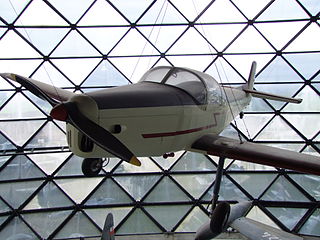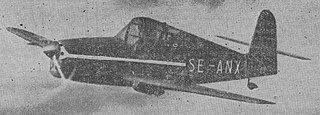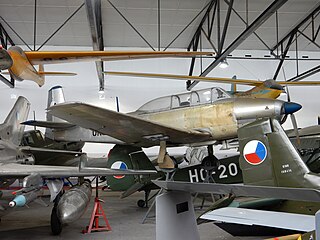
The Piaggio PD.808 was an Italian business jet built by Piaggio. It was designed as a joint venture between Piaggio and Douglas Aircraft Company of Long Beach, California, United States.

The Auster J/1U Workmaster is a late 1950s British single-engined single-seat high-wing agricultural monoplane built by Auster Aircraft Limited at Rearsby, Leicestershire. Of traditional high-wing layout, it carries 90 gallons of spray fluid in a tank beside the pilot, an extra seat being provided for a passenger. The Lycoming 0-360-A engine of 180 h.p. driving a McCauley v.p. propeller giving it ample power; and slotted ailerons and balanced tail controls providing good handling. Oversize tyres were fitted. Take-off run at 2,550 lb gross weight and cruising speed at 65 per cent power are respectively 180 yd and 88 miles per hour (142 km/h). Britten-Norman spray gear was provided by Crop Culture, and this company ordered nine Workmasters.

The Agusta AZ.8L, or Agusta-Zappata AZ.8L, was an Italian airliner prototype first flown on 9 June 1958. It was of conventional low-wing monoplane configuration with tricycle undercarriage and all-metal construction. Filippo Zappata's design grew out of a twin-engined transport designated AZ.1 that was never built.

The Piaggio P.166 is an Italian twin-engine pusher-type utility aircraft developed by Piaggio Aero. The aircraft model name was Portofino, and is also known as Albatross in South African military service.

The LIBIS KB-6 Matajur was a 1950s Slovenian two-seat light monoplane designed and produced by LIBIS aircraft during Yugoslavian period.

The AS/SA 202 Bravo is a two to three-seat civil light aircraft jointly designed and manufactured by the Swiss company Flug- und Fahrzeugwerke Altenrhein (FFA) and the Italian company Savoia-Marchetti. The aircraft was designated the AS 202 in Switzerland, and the SA 202 in Italy.

The Piaggio P.149 is a 1950s Italian utility and liaison aircraft designed and built by Piaggio. The aircraft was built under licence by Focke-Wulf in West Germany as the FWP.149D.

The Piaggio P.150 was a 1950s Italian two-seat trainer designed and built by Piaggio to meet an Italian Air Force requirement to replace the North American T-6.
The Partenavia P.59 Jolly was an Italian two-seat training monoplane designed by Partenavia to meet a requirement for the Aero Club d'Italia. First fight was in 1960.
The Hispano HS-42 and its derivative, the HA-43, were advanced military trainer aircraft produced in Spain in the 1940s. The basic design was that of a conventional, low-wing, cantilever monoplane with seating for the pilot and instructor in tandem. The HS-42 had fixed, tailwheel undercarriage with spatted mainwheels, while the HA-43 had retractable main units. Produced on the assembly line that had been used to build Fokker D.XXI fighters, the HS-42 shared some components with this aircraft.
The Partenavia P.55 Tornado was a 1950s Italian high-performance competition and touring monoplane built by Partenavia. The Tornado was a small mid-wing cantilever monoplane with a retractable tricycle landing gear. The aircraft was powered by a nose-mounted Lycoming O-320 piston engine.

The SAI KZ VII Lærke was a light utility aircraft built in Denmark shortly after the Second World War. Based on the SAI KZ III air ambulance, the KZ VII was a strut-braced, high-wing monoplane of conventional design with an enclosed cabin for four seats. Fifty-six aircraft were built, and another 22 partially completed aircraft were destroyed in a factory fire in 1947. The Danish Air Force operated 10 of the type as trainers between 1950 and 1977.

The Macchi MB.323 was an Italian single-engine basic training monoplane designed and built by Macchi. No orders were placed and only a prototype was built.

The Sparmann S-1 was a 1930s Swedish military training monoplane, designed by Edmund Sparmann, built in small numbers for the Swedish Air Force. The S-1 was a single-seat low-wing braced-monoplane with a fixed trail-skid landing gear. It was powered by a single 130 hp (97 kW) de Havilland Gipsy Major engine.

The Mosscraft MA.1 was a British light two-seat low-winged sporting monoplane of the 1930s.

The Ambrosini Rondone is an Italian-designed two/three-seat light touring monoplane of the early 1950s.

The Skandinaviska Aero BHT-1 Beauty is a 1940s Swedish single-seat light monoplane designed by E. Bratt, K.E. Hilfing and B.Törnblom and built by Skandinaviska Aero of Stockholm.
The I.S.T. L-17 Masang was a two-seat, single engine, low wing monoplane aircraft designed and built in the Philippine Republic in the mid-1950s. It was intended for both touring and training.
The OFW OK-15 was a 1950s Austrian two-seat light aircraft. Designed by Otto Kauba and built by the Österreichische Flugzeugwerke GmbH (OFW) at Wiener Neustadt, it was the first aircraft to be designed and built in Austria for 20 years.

The TOM-8 was a prototype Czechoslovak single-engined two-seat training aircraft of the 1950s. It was designed by the VZLU, the Czechoslovak national aeronautic research institute for the Czechoslovak Air Force, with a prototype flying in 1956, but production plans were abandoned in 1960.















